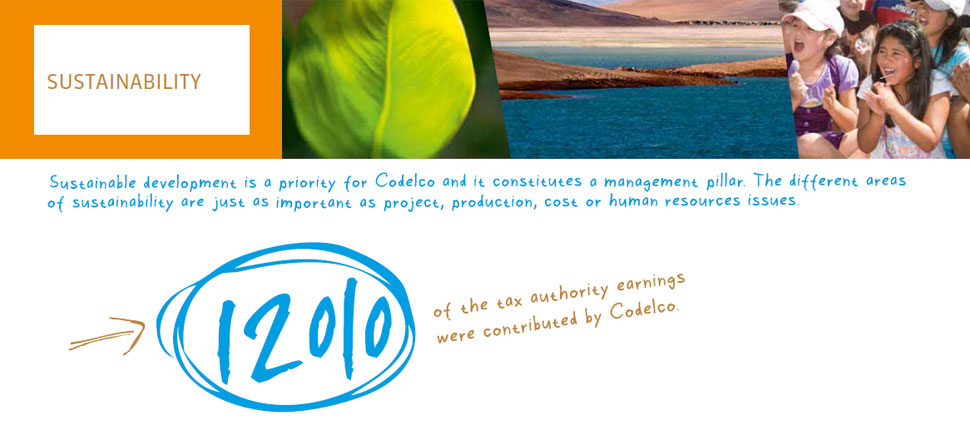
In 2011 Codelco promoted a new approach to sustainable development, strengthening its strategic pillar. Management was mainly focused on protecting the life and health of employees; respect for the environment, and the development of communities close to operations and projects.
Strategy
Codelco has set itself the challenge to transform its approach to sustainability. For this purpose, in 2011 it created the Sustainability and Corporate Affairs General Management, that is under the Executive Presidency and its main objective is to promote the strategic position of sustainability topics, and face the Company�s current and future challenges in accordance with Codelco�s values and policies. The division sustainability departments were also reorganised.
Similarly, a functional relationship was defined for the new sustainability managements, the occupational health and safety managements with the company�s corporate level.
In this context, in 2011 Codelco implemented an Occupational Health and Safety Structural Project and an Environment and Community Structural Project. Both initiatives focused on closing or mitigating the gaps in these critical issues and transforming management, ensuring performance excellence in the future so that the company is seen as setting the standard for these topics by 2020.
Investments
In 2011, environmental investments totalled US$ 65 million. Key investments were the construction of new stages or tailings dams expansions at Chuquicamata, Salvador and El Teniente division; mitigation measures focused on particulate matter at Ventanas Division, and construction work to intercept effluent water at Andina Division.
In 2011, Codelco invested US$ 185 million in occupational health and safety. Key investments included improvement of fire systems at Radomiro Tomic Division and lighting system improvements at Chuquicamata Division.
Environment and Community Structural Project
The Company decided to address socio-environmental management with �a new approach� in the context of Corporate Governance, the organisational institutional structure and current interests of society.
The Project has two action lines. One focused on closing the environmental and social gaps; and the other on transforming management to ensure performance excellence in the future and position Codelco as the leading company that sets the standards for these topics by 2020, contained in four management areas:
- Socio-Environmental Vulnerabilities
- Regulatory Compliance Control
- Corporate Standards
- Environmental and Social Responsibility Culture
Additionally, 11 environmental and community standards were defined to organise and simplify management and performance, in response to key environmental and community impacts of our operations and projects.
Environmental and Community Standards
- Air emissions
- Energy and climate change
- Water resources and liquid waste
- Solid Waste
- Mass mineral waste
- Territory, soil and landscape
- Biodiversity
- Work closure
- Community development
- Community relationships
- Indigenous peoples

Occupational Health and Safety Structural Project
This initiative represents a change in how we undertake occupational health and safety management; its goal is to create a unique and systematic methodology to control standard compliance, skill creation and ongoing verification and control, contained in the five key management areas listed below:
- Fatality Control Standards
- Occupational Health Standards
- Leadership
- Behavioural Safety
- Learning
In 2011, Fatality Control Standards were created to identify the main causes of accidents in the organisation and 12 standards were defined that are uniformly applied across the Company, and 7 specific standards that set minimum lines that must be met in relation to people, the organisation and equipment and facilities; their goal is to eliminate or control serious or fatal accidents.
Workplace Health Standards were also defined to provide a healthy and safe workplace for all employees, keeping hazards, factors and agents that may cause work-related accidents or professional diseases under control. These 10 standards are mandatory at all Codelco operations and projects. Furthermore, work was started on defining operational and engineering standards for ergonomics, arsenic, noise and silica agents.
Standards
Fatality Control- Insulation, Blocking and Work Permit
- Working at Height
- Heavy-Duty Equipment
- Light-Weight Vehicles
- Portable and Manual Equipment and Tools
- Molten Materials
- Lifting and Suspended Loads
- Equipment protections
- Hazardous Substance Management
- Explosives and Blasting
- Site Control
- Fire
Fatality Control (special)
- Railway Operations
- Mud Water Control (pumping)
- Port Operations
- Gas and Oxygen Control in Underground Mining
- Rockburst
- Avalanche
- Flights
Workplace Health
- Workplace Health Management
- Occupational Health Surveillance
- Occupational Hygiene
- Ergonomics
- Compatible Health Pre-Occupational & Occupational Exams
- Fatigue and Drowsiness
- Biopsychosocial factors
- Alcohol, Drugs and Tobacco
- Restrictions, Relocations, Work Re-education & Rehabilitation
- Maternity

Performance Indicators
Occupational Health and Safety
Accident Incident Rate
In 2011 Codelco�s disabling injury frequency rate was the lowest in company history, with an overall rate of 1.39 injuries per million hours worked, improving 31% over 2010. This is significant progress in our goal to have below 1 rate in the coming years, and it is clearly due to both the effort and work carried out in the Occupational Health and Safety Structural Project, and to a major change in how safety is managed within the Company. The severity rate for employees and contractors was 335, down 32% from 2010.
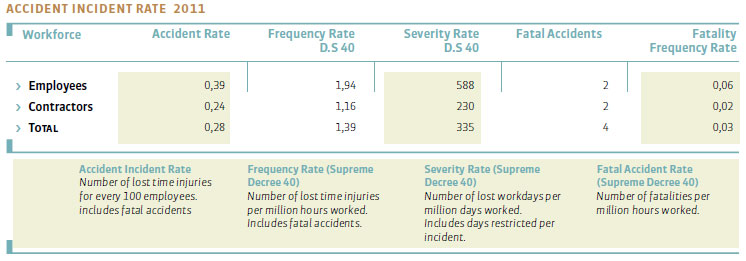
Occupational Health and Safety
In the framework of the Global Programme for the Elimination of Silicosis from the World by 2030, an agreement was made with the Public Health Institute so that this specialised public body conducted silica monitoring at divisions exposed to this agent. Personal controls were conducted and an efficiency test of the respiratory protection or portacount was carried out, which were implemented across Codelco and reports were received from the Public Health Institute.
Fatalities
In 2011, Codelco had to regret the death of four workers, two contractors and two employees. We refer to: Dany Elvys Cruz Nogales, Luis Ricardo Gonz�lez Castro, Sergio Andr�s Machuca Meneses and Juan Ram�n Troncoso Avenda�o. As a result, we must reflect upon and improve our efforts in management and implementation of strict barriers to control the occurrence of new severe and fatal incidents.

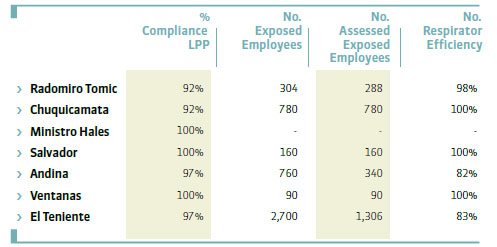
In 2011, there were 51 new disability resolutions by diagnosis for employees (over 15% disability), This represents a 42% decline from 2010.

Environment
Liquid Waste
The Company�s general inventory of liquid waste dropped from 25 in December 2010 to 15 liquid wastes in 2011, as detailed in the following table:
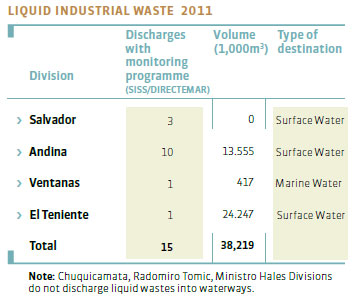
Solid Waste
Codelco has Corporate Guidelines for Solid Industrial Waste (RISes) since 2010 that provide the basis to ensure sustainable management of solid industrial waste.
Key events during the year were: implementation in progress of Phase II -Mine Closure Plan for Cerro El Minero, El Teniente Division. The overall plan includes the removal of 100,000 tonnes of arsenic waste from the division�s safe disposal site over a period of six years which will cost approximately US$ 36 million. During this year, 18,000 tonnes were removed in addition to the 47,000 tonnes that had already been removed.
Meanwhile, Ventanas Division reduced 5, 441 tonnes of ferric arsenate which was sold for treatment and recovery.
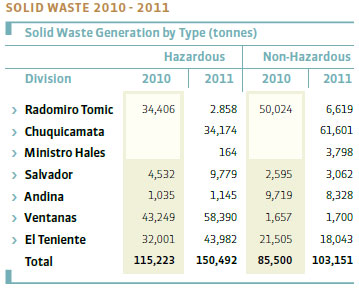
Smelter Emissions
Codelco has four copper concentrate smelters that mainly generate sulphur dioxide (SO2 ) and arsenic (As) emissions. These smelters are regulated by emission standards and decontamination plans for cities where these plans are applied.
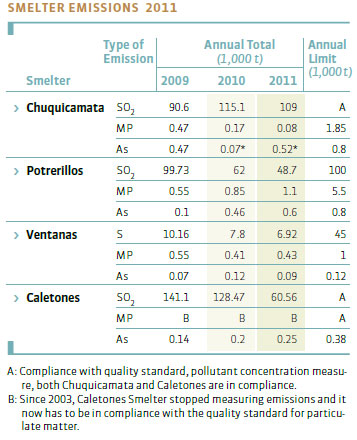
Energy
As in previous years, in 2011 all Codelco divisions and Minera Gaby S.p.A. committed to energy efficiency management with a monthly follow-up of electricity and fuel consumption intensity levels. Energy efficiency workshops were also held to share information on best practices and to present initiatives in progress.
As for greenhouse gas emissions, Codelco has an energy information system to quantify direct and indirect emissions associated with each type of energy consumption.
In 2011, a climate change work session was held to discuss and analyse the main events and progress made in this area, as well as regulations and effects on the Company�s results.

Water Resources
In 2011, Codelco implemented a Water Resources Corporate Instrumentation Plan, to report to authorities about the Company�s fresh water usage, in response to the �Agreement Protocol for Water Efficiency in Mining,� signed in 2009 by Codelco through the Mining Council, with the Ministry of Mining, the Ministry of Public Works, the General Water Board and Sonami. It also updated the Water Resources Corporate Master Plan with short, medium and long-term metrics.
Site Closure
Law No. 20,551 regulates Mine Site and Facility Closure effective in November 2012, and complemented by regulations that detail its provisions and define the content of certain issues not solved by this law.
In the case of Codelco�s mine operations, it must, among other requirements, obtain the approval for its closure plans, assess them and give the Chilean State financial guarantees to ensure compliance. It must also regularly update closure plans and have them audited by external auditors.
Codelco also incorporates in its closure plans the implications of its structural projects (Radomiro Tomic Sulfuros, Chuquicamata Underground, Ministro Hales Mine , San Antonio, PEA 244, Teniente New Mine Level) and the Minera Gaby S.p.A. closure plan will be prepared.
Financial guarantees must be given for the updated amount related to closure works contained in the plan; therefore, the remaining useful life of the mine will have to be included, applying a discount rate equivalent to Central Bank BCU Bonds issued in UF�s, minimum 10-year bonds. The guarantee consists of an instrument portfolio, which varies as the effective closure phase gets nearer, and its instruments become increasingly safe and liquid.
This regulation also sets out special provisions for mine and exploration closure plans with capacity to mine less than 10,000 tonnes per month. Likewise, it establishes a fund used by the State to finance postclosure works.
For these purposes, existing mine operations must comply with a series of stages defined by this law; in brief, they must have these guarantees by mid-2015.
Project Environmental Assessment
In 2011, Codelco entered 15 projects into the Environmental Impact Assessment System (EIAS), 14 were Environmental Impact Statements (EIS) and 1 Environmental Impact Study (EISt), with the investments amounts, indicated in the following table:
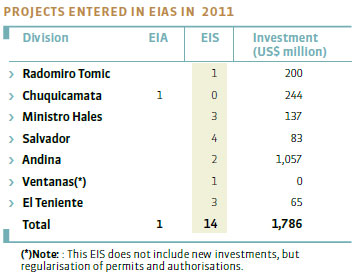
Furthermore, during 2011 two projects, entered as Environmental Impact Studies in 2010, were approved: �New Mine Level� at El Teniente Division and �Plant for the Recovery of Copper and Molybdenum in Tailings� at Andina Division, in addition to 7 Environmental Impact Statements entered and approved during 2011.
Environmental Incidents
Codelco has Corporate Guidelines to Record, Classify and Investigate Events with Environmental Consequences that guide management and establish the classification baseline. The events are classified based on the severity level, taking into account the type of incident, its duration, the amount of substance emission and the affected location.
In 2011, the Company recorded a total of 30 incidents with environmental consequences; 15 are classified as serious and 3 as major incidents.
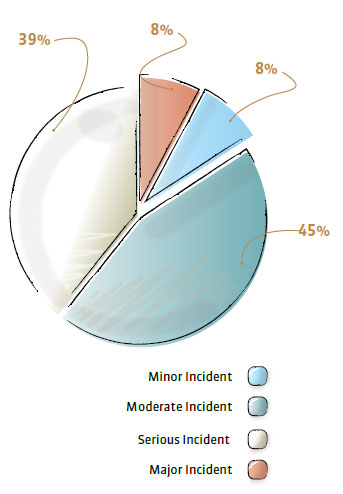
La Greda: Environmental Investments
In March 2011, an unexpected environmental event occurred at Escuela de La Greda, a primary school in the district of Puchuncav�, affecting the health of adults and children.
From that moment onwards, Codelco has made significant investments and has implemented measures to mitigate the impacts our operations may have on La Greda town. Since March, the company has invested more than US$ 10 million to confine our concentrate collection centres and mitigate emissions and dispersion.
Key environmental investments made at Ventanas Division after the March 2011 episode are as follows:
- Investment plan to mitigate particulate matter (concentrate): shed roofing, protection screens in collection yards, internal road surface treatment and creation of green areas in the slag heap.
- Modification and improvement of operational procedures and in situations of critical weather conditions.
- Capacity to forecast weather conditions: Predictive weather monitoring, 24 hours, 7 days a week, obtaining 24 and 48-hour weather forecasts. Conduct preventive air, water, soil and food monitoring in the area.
- Work session: With the community that has been most affected by these incidents and implementation of community projects (grant funds and a social investment fund).
- Clean Production Agreement (APL): Codelco signed a Commitment with the Ministry of the Environment, the National Clean Production Council and 10 companies (public-private sector) in the Puchuncav�-Quintero industrial park (10 December 2011).
- Key commitments, all have performance indicators
and implementation timelines that go from 6 to 24
months:
- Activities to preserve and protect the Campiche wetlands.
- Slag management plan.
- Plan to clean affected soil inside Ventanas Division.
- Replace technology to reduce �black smoke�.
- New design to discharge copper concentrate.
- Different enhancements to improve plant�s energy efficiency.
- New operational and emergency procedures
- Valpara�so - Ventanas Health Seremi Protocol (first week of December): Codelco Ventanas and Health Seremi signed the protocol:
- Deliver online information to air quality monitoring stations.
- Reduction of fugitive gases: operation plan to reduce gas flow and emission processes.
Codelco joins ICMM
In October de 2011, Codelco rejoined the International Council on Mining and Metals (ICMM), the most important international mining association that addresses sustainable development. Hence, Codelco has made an open and collaborative commitment to improve its sustainability performance; and it will publicly report its performance to this international organisation on an annual basis.
The ICMM is an agent for change in terms of the social and environmental responsibilities of its members. It represents leading companies working together to strengthen the contribution of mining, minerals and metals to sustainable development.

Online Environmental Commitments
In 2011, Codelco was the first company to voluntarily enter its environmental commitments into the new online system of the Superintendency of the Environment. The website is a virtual library where companies may voluntarily report their environmental commitments made with the Environmental Assessment Service under the Ministry of the Environment. This system improves enforcement by organising and systematising the information and makes processes more transparent, since the website has public access.
Calama Plus Plan
Calama Plus Sustainable Urban Development Plan aims to build and agree on a future urban development plan for the city of Calama, based on the cooperation and participation of inhabitants, authorities, Codelco and other major companies that operate in the city.
The plan results from an agreement signed by the Municipality of Calama, the Regional Government of Antofagasta and a group of companies in the area, committed to creating a common and comprehensive plan for the city and design emblematic projects that contribute to the quality of life of the people who live in the capital of the Loa Province.
The Calama Plus Plan has developed an extensive and deep process to engage all the community, establishing a permanent dialogue with the various social organisations for the collective development of this initiative. Several open citizens� forums have been held and a series of specific forums on project co-production, and other initiatives, for instance face-to-face and digital participation tools - such as the implementation of a permanent open house.
During the first stage it focused on designing a master plan for the city to identify priorities and projects that, applying a reality criterion, may be developed in the city, based on three principles:
- Preserve the oasis and extend its conditions to the rest of the city,
- Develop urban areas with higher standards, and
- Promote initiatives that strengthen social and human capital.
Social Responsibility
In 2011, Codelco developed a new vision that guides the focus from current community management towards an effective development of the communities close to its operations and projects. This new vision is consistent with Codelco rejoining ICMM and the requirements of this organisation in terms of social responsibility and community relations. Hence, Codelco adopted the development concept as a process to strengthen communities, improving quality of life and engaging them in the decision-making process in order to increase the control they have over their lives in the long term, as defined by ICMM.
At the same time, with the support of the University of Queensland and its Centre for Social Responsibility in Mining, Codelco started a detailed review of its relationship with communities. In 2012, Codelco will have an exhaustive diagnosis and work plan to move forward and become a world leader in this field.
Key events during 2011 are: Chuquicamata Division was awarded the Best CSR Practices award for Latin America by the Mexican Philanthropy Centre (CEMEFI) and Forum Empresa, in the category Community Engagement, because of the support it has provided to build and refurbish the Museum in the town of Lasana, dedicated to rescuing and promoting the natural and cultural heritage of the Atacama desert.
Community Development Projects and Social Investment Fund
In 2011, the Company maintained and promoted the implementation of community development projects - Codelco Buen Vecino (Codelco Good Neighbour) alliance with social organisations, and public and private institutions near its operations and investment projects.
More than 566 shares were backed totalling about US$ 6.5 million1. Also, approximately US$ 2.2 million of remaining Sence funds were assigned to social grants for job training provided by Technical Training Organisations to unemployed community sectors, preferably in areas close to operations and projects.
In addition to the Codelco Buen Vecino social projects implemented by the divisions, Codelco has a Social Investment Fund grant especially to finance and promote education and environmental initiatives in communities that form part of the influence area of operations and projects.
In 2011, the divisions and Exploration Management presented 22 projects to the Social Investment Fund. A Selection Committee � formed by Codelco executive and professional employees � assessed the projects based on the technical and financial indicators, approving 16 initiatives for the fund�s US$ 300,000.
The following are some of the Codelco Buen Vecino social initiatives developed in 2011:
Radomiro Tomic
The division centred its work with communities on improving the quality of education, social integrity and urban afforestation, as elements that improve the quality of life of neighbours.
Key projects are the agreements with Corporaci�n Nacional Forestal�Conaf; and with the Loa Provincial Government to improve school infrastructure.
Chuquicamata
The division implemented projects mainly to improve quality of education, social integration and to support culture and local development.
Key projects were the Calama Participa and Calama Mi Sol grant funds that, through lessons given by the distinguished Chilean pianist Roberto Bravo, aims to create a chamber orchestra for the city.
With contributions from Codelco�s Social Investment Fund, healthy life styles were promoted in the school community at Liceo Am�rica in Calama; and it also promoted social reintegration, through education and employment, implementing carpentry and welding workshops given to convicted offenders at the Centro Ojos de Opache.
Ministro Hales
This new Division started implementing a community development plan focused on local communities and on collaborating and searching for mutual benefit as a tool to grow together with the community.
With the co-funding provided by the Codelco Social Investment Fund, the division carried out the Radio Comunitaria Escuela Valent�n Letelier project, a school community radio to boost the school�s communication with its environment and reinforce learning in an entertaining and motivating manner.
Salvador
The division implemented various projects in the Cha�aral Province, especially in education and training, as well as promoted the use of sustainable resources. With the contribution made by the Social Investment Fund, school vegetable gardens were developed with plants using sullage water, ensuring the reuse of resources used for irrigating the vegetable gardens.
Together with the National Nursery School Board (Junta Nacional de Jardines Infantiles - Junji) work was conducted to understand the environmental, local, social and cultural environment of small children, by developing didactic boxes. It also supported learning new technologies in secondary schools in the district of Diego de Almagro and Cha�aral, providing training to use interactive whiteboards.
Workshops were held to build homemade solar collectors and applied heliotechnique courses were organized through social grants using the Sence surplus.
Andina
The division supported social projects promoted by the community, mainly by jointly organising work sessions, with 191 organisations, developing ten initiatives on average.
During the year, the division continued supporting the Los Andes Children�s Symphony Orchestra, which has effectively helped children and teenagers at risk through social inclusion, fostering expectations and improving their studying habits and discipline that involve the whole family group.
Ventanas
With the Puchuncav� and Quintero municipalities, the division supported small-scale farming and developed projects mainly focused on improving the quality of education, cultural, sports and recreational activities.
With the support of the Social Investment Fund, projects were implemented to promote the efficient use of renewable energy resources � water and solar � in municipal schools under the Quintero municipality.
El Teniente
The division developed projects to improve the quality of education, to protect the environment and to afforest urban areas. Furthermore, it continued working with the Corporaci�n Pro O�Higgins that promotes initiatives to develop the region and its human capital.
During the year, it continued implementing projects that incorporate environmental content in schools and nurseries in its area of influence. With corporate help, initiatives were implemented to instil good environmental practices at schools in Rancagua, to talk about copper mining to third and fourth year primary school pupils and promote healthy life styles in schools in the district of Alhu�.
Exploration
Exploration Management continued to focus on community development in the vicinity of its operations. With the contributions made by the Social Investment Fund, a sullage water recovery plant was implemented and the water was reused to irrigate the arboreous species at the Escuela E-42 school, Pedro Vergara Keller de Calama. Additionally, talks concerning �The Sustainable Development of Life and the Rational Use of Water� were given to Conaf and the school�s Green Brigade, which showed pupils and parents the importance and responsibility in caring for water resources.
Corporate Centre
For the second consecutive year, the alliance between Codelco and the Municipality of Mejillones helped to create and subsequently develop the Mejillones School Children�s Symphony Orchestra in the district of Mejillones. In keeping with the line originally set by the children�s orchestra in Los Andes, this project, co-funded by the Social Investment Fund, has opened new growth and development horizons for more than seventy children in the district. Most of these children are socially vulnerable and at risk.

World Class Suppliers
The World Class Supplier Programme aims to consolidate collaborative networks with goods and services suppliers that have the technical capacity to develop innovative solutions with emphasis on problems with internal customers that the traditional market has not covered so far, or has not solved appropriately. Potential growth requires more collaborative than transactional relationships that are stable and durable and favour joint investment for innovation in mining and sustainable development of capacity in the long run. This programme is an experience shared with BHPBilliton.
